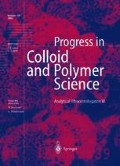Abstract
Sedimentation equilibrium methods which are able to establish a solubility gradient for inorganic species in an ultracentrifugal field are presented. These methods are generally based on the concepts of density gradient and sedimentation equilibrium ultracentrifugation. However, in addition to the formation of a density or an equilibrium gradient, physicochemical parameters such as the pH or the solvent quality are varied throughout the solution column if appropriate high-density or high-molar-mass solutes are chosen or a mixture of solvents with different density is applied. This is demonstrated for two types of solubility gradients including for the case of a pH gradient; parameters for the adjustment of the overall pH are discussed. pH gradients were formed up to 3 pH units and are sensitive to addition of electrolytes, so they can only be applied to sparingly soluble salts. The gradual variation of the solubility of inorganic particles leads to the dissolution of the particles upon sedimentation when the dissolution point is reached. The ionic species formed show increased diffusion compared to the sedimenting particles, so they can diffuse back to regions of lower solubility and thus form a crystal again. This finally leads to an equilibrium situation for the critical crystal nucleus. In the case of a pH gradient with CdS, it is demonstrated that a transition from particles to dissolved ions indeed takes place and can be monitored in the analytical ultracentrifuge. For BaCrO4, the transition to the more soluble BaCr2O7 with decreasing pH can readily be monitored via the associated spectral changes, clearly demonstrating the possibility to perform chemical reactions in a pH gradient.
Access this chapter
Tax calculation will be finalised at checkout
Purchases are for personal use only
Preview
Unable to display preview. Download preview PDF.
References
Gibbs JW (1961) The collected works of JW Gibbs. Yale University Press, New Haven
Kashchiev D (1982) J Chem Phys 76:5098
Oxtoby DW, Kashchiev D (1994) J Chem Phys 100:7665
Oxtoby DW (1998) Acc Chem Res 31:91
Mutaftschiev B (1993) In: Hurle DTJ (ed) Handbook of crystal growth. Elsevier, Amsterdam, p 189
Yau ST, Vekilov PG (2000) Nature 406:494
Oxtoby DW (2000) Nature 406:464
Cölfen H, Pauck T (1997) Colloid Polym Sci 275:175
Vossmeyer T, Katsikas L, Giersig M, Popovic IG, Diesner K, Chemseddine A, Eychmüller A, Weller H (1994) J Phys Chem 98:7665
Hollemann AE, Wiberg N (1985) Lehrbuch der anorganischen Chemie, 91st edn. de Gruyter, New York, p 1042
Cölfen H, Pauck T, Antonietti M (1997) Progr Colloid Polym Sci 107:136
Börger L, Cölfen H (1999) Progr Colloid Polym Sci 113:23
Börger L, Cölfen H, Antonietti M (2000) Colloids Surf A 163:29
Qi L, Cölfen H, Antonietti M (2000) Angew Chem Int Ed Engl 39:604
Author information
Authors and Affiliations
Editor information
Rights and permissions
Copyright information
© 2002 Springer-Verlag
About this paper
Cite this paper
Lucas, G., Börger, L., Cölfen, H. (2002). Solubility equilibrium gradients in the analytical ultracentrifuge: an approach towards the isolation of critical crystal nuclei in solution. In: Borchard, W., Straatmann, A. (eds) Analytical Ultracentrifugation VI. Progress in Colloid and Polymer Science, vol 119. Springer, Berlin, Heidelberg. https://doi.org/10.1007/3-540-44672-9_2
Download citation
DOI: https://doi.org/10.1007/3-540-44672-9_2
Published:
Publisher Name: Springer, Berlin, Heidelberg
Print ISBN: 978-3-540-42489-5
Online ISBN: 978-3-540-44672-9
eBook Packages: Springer Book Archive

